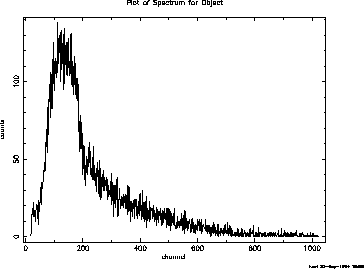|
|
Next: Distribution Up: FTOOLS: A FITS data Previous: Online Help
ExampleAs an example of the use of the FTOOLS, consider a FITS data set of photon events from an supernova remnant made by an X-ray imaging telescope which has within its field of view a calibration source. First the structure of the FITS dataset need to be determined. This is accomplished with the fstruct task. Using the Host FTOOLS this would look like
ftools.gsfc.nasa.gov kent[1] % fstruct raw.evt No. Type EXTNAME BITPIX Dimensions(columns) PCOUNT GCOUNT 0 PRIMARY 32 0 0 1 1 BINTABLE EVENTS 8 30(12) 55753 0 1 2 BINTABLE STDGTI 8 16(2) 139 0 1 From this it is determined that the photon events are located in the first extension, which is a FITS binary table extension with 55753 rows (events). Now determine the format of the table using the flcol task to list the names of the columns
ftools.gsfc.nasa.gov kent[2] % flcol raw.evt+1
___Column_Names_________Formats__________Units___
TIME 1D s
X 1I pixel
Y 1I pixel
PHA 1I channel
PI 1I channel
RISE_TIME 1I
There are several columns in this data set. Using the X and Y columns, basic statistics can be learned about these columns with the fstatistic task or an image can be built up from the photon list using the f2dhisto. Using the PHA column and the fhisto task a quick-look spectrum can be made and viewed with fplot (see spectrum on top in Figure 2).
Now through the use of these FTOOLS tasks one determines that the supernova remnant is centered at (114,129) in the pixel space of the image with a radius of 40 pixels. Using the fselect task to select out only the photons associated with the supernova and the background and then the fhisto task on the resulting supernova events, the spectrum on the right in Figure 2 having no calibration peak is binned and then viewed.
ftools.gsfc.nasa.gov kent[3] % fselect raw.evt+1 snova.evt Name of output FITS file[] snova.evt Selection Expression[] sqrt((X-114)**2 + (Y-129)**2) < 40 ftools.gsfc.nasa.gov kent[4] % fhisto snova.evt+1 spec.fits PHA 1 The FTOOLS distribution comes complete with a User's Guide which has a short tutorial going into more detail about the use of FTOOLS. Other references discussing the FTOOLS such as (Blackburn and Pence, 1994) and the IRAF documentation are also available to learn more on the FTOOLS software package.
   Next: Distribution Up: FTOOLS: A FITS data Previous: Online Help Lawrence Elwin Brown Mon Dec 5 11:27:10 EST 1994 |


 Click for encapsulated Postscript
Click for encapsulated Postscript  Click for encapsulated Postscript
Click for encapsulated Postscript